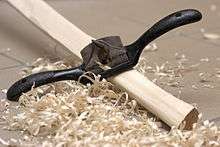Spokeshave
A spokeshave is a tool used to shape and smooth woods in woodworking jobs such as making wheel cart wheel spokes, chair legs,[1] paddles, bows, and arrows. Historically, a spokeshave was made with a wooden body and metal cutting blade. With industrialization metal bodies displaced wood in mass-produced tools.


History
Prehistoric spokeshaves were made of stone. In archaeology, the term spokeshave is used to describe a tool, usually a uniface, that has at least one retouched lunate notch in one edge. In a sense, the term is a descriptive "catch-all" category, since it is difficult to determine if this was actually the way in which such a tool was used; the categorization is based entirely on the appearance of the tool.
Types

Spokeshaves can be made from flat-bottom, concave, or convex soles, depending on the type of job to be performed.[2] Spokeshaves can include one or more sharpened notches along which the wooden shaft is pulled in order to shave it down to the proper diameter. Historically, spokeshave blades were made of metal, whilst the body and handles were wood. An early design consisted of a metal blade with a pair of tangs to which the wooden handles were attached, as with a drawknife. Unlike a drawknife, but like a plane, spokeshaves typically have a sole plate that fixes the angle of the blade relative to the surface being worked. By the twentieth century metal handles and detachable blades had become the most common.
A convex, wooden, variant of the spokeshave is called a travisher.[3]
Further reading
- Adamson, John, "Spokeshaves: planing without a straight face", Furniture & Cabinetmaking, issue 260, August 2017, pp. 54–7
- Hawley, Ken, & Watts. Denis (2007), Wooden Spokeshaves Sheffield: The Hawley Collection Trust Ltd in association with the TATHS ISBN 9780947673178 OCLC 137272911
References
| Wikimedia Commons has media related to Spokeshaves. |
- Encyclopedia of Furniture Making; by Ernest Joyce and Alan Peters
- "Spokeshaves - Canadian Woodworking Magazine". www.canadianwoodworking.com. Retrieved 2018-08-07.
- "Travisher". Highland Woodworking.